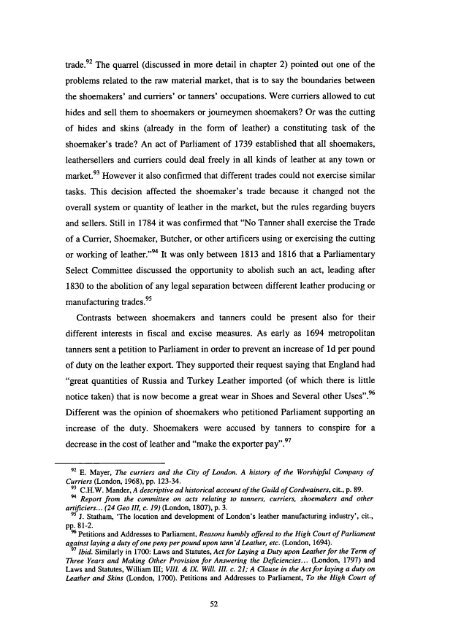The Boot and Shoe Trades in London and Paris in the Long Eighteenth Century
The Boot and Shoe Trades in London and Paris in the Long Eighteenth Century
The Boot and Shoe Trades in London and Paris in the Long Eighteenth Century
You also want an ePaper? Increase the reach of your titles
YUMPU automatically turns print PDFs into web optimized ePapers that Google loves.
trade. 92 <strong>The</strong> quarrel (discussed <strong>in</strong> more detail <strong>in</strong> chapter 2) po<strong>in</strong>ted out one of <strong>the</strong><br />
problems related to <strong>the</strong> raw material market, that is to say <strong>the</strong> boundaries between<br />
<strong>the</strong> shoemakers' <strong>and</strong> curriers' or tanners' occupations. Were curriers allowed to cut<br />
hides <strong>and</strong> sell <strong>the</strong>m to shoemakers or journeymen shoemakers? Or was <strong>the</strong> cutt<strong>in</strong>g<br />
of hides <strong>and</strong> sk<strong>in</strong>s (already <strong>in</strong> <strong>the</strong> form of lea<strong>the</strong>r) a constitut<strong>in</strong>g task of <strong>the</strong><br />
shoemaker's trade? An act of Parliament of 1739 established that all shoemakers,<br />
lea<strong>the</strong>rsellers <strong>and</strong> curriers could deal freely <strong>in</strong> all k<strong>in</strong>ds of lea<strong>the</strong>r at any town or<br />
market. 93 However it also confirmed that different trades could not exercise similar<br />
tasks. This decision affected <strong>the</strong> shoemaker's trade because it changed not <strong>the</strong><br />
overall system or quantity of lea<strong>the</strong>r <strong>in</strong> <strong>the</strong> market, but <strong>the</strong> rules regard<strong>in</strong>g buyers<br />
<strong>and</strong> sellers. Still <strong>in</strong> 1784 it was confirmed that "No Tanner shall exercise <strong>the</strong> Trade<br />
of a Currier, <strong>Shoe</strong>maker, Butcher, or o<strong>the</strong>r artificers us<strong>in</strong>g or exercis<strong>in</strong>g <strong>the</strong> cutt<strong>in</strong>g<br />
or work<strong>in</strong>g of lea<strong>the</strong>r."94 It was only between 1813 <strong>and</strong> 1816 that a Parliamentary<br />
Select Committee discussed <strong>the</strong> opportunity to abolish such an act, lead<strong>in</strong>g after<br />
1830 to <strong>the</strong> abolition of any legal separation between different lea<strong>the</strong>r produc<strong>in</strong>g or<br />
manufactur<strong>in</strong>g trades.95<br />
Contrasts between shoemakers <strong>and</strong> tanners could be present also for <strong>the</strong>ir<br />
different <strong>in</strong>terests <strong>in</strong> fiscal <strong>and</strong> excise measures. As early as 1694 metropolitan<br />
tanners sent a petition to Parliament <strong>in</strong> order to prevent an <strong>in</strong>crease of id per pound<br />
of duty on <strong>the</strong> lea<strong>the</strong>r export. <strong>The</strong>y supported <strong>the</strong>ir request say<strong>in</strong>g that Engl<strong>and</strong> had<br />
"great quantities of Russia <strong>and</strong> Turkey Lea<strong>the</strong>r imported (of which <strong>the</strong>re is little<br />
notice taken) that is now become a great wear <strong>in</strong> <strong>Shoe</strong>s <strong>and</strong> Several o<strong>the</strong>r Uses".96<br />
Different was <strong>the</strong> op<strong>in</strong>ion of shoemakers who petitioned Parliament support<strong>in</strong>g an<br />
<strong>in</strong>crease of <strong>the</strong> duty. <strong>Shoe</strong>makers were accused by tanners to conspire for a<br />
decrease <strong>in</strong> <strong>the</strong> cost of lea<strong>the</strong>r <strong>and</strong> "make <strong>the</strong> exporter pay".97<br />
E. Mayer, <strong>The</strong> curriers <strong>and</strong> <strong>the</strong> City of <strong>London</strong>. A history of <strong>the</strong> Worshipful Company of<br />
Curriers (<strong>London</strong>, 1968), pp. 123-34.<br />
C.H.W. M<strong>and</strong>er, A descriptive ad historical account of <strong>the</strong> Guild of Cordwa<strong>in</strong>ers, cit., p. 89.<br />
' Report from <strong>the</strong> committee on acts relat<strong>in</strong>g to tanners, curriers, shoenakers <strong>and</strong> o<strong>the</strong>r<br />
artficiers... (24 Geo III, c. 19) (<strong>London</strong>, 1807), p. 3.<br />
J. Statham, '<strong>The</strong> location <strong>and</strong> development of <strong>London</strong>'s lea<strong>the</strong>r manufactur<strong>in</strong>g <strong>in</strong>dustry', cit.,<br />
pp. 81-2.<br />
Petitions <strong>and</strong> Addresses to Parliament, Reasons humbly offered to <strong>the</strong> High Court of Parliament<br />
aga<strong>in</strong>st lay<strong>in</strong>g a duty of one peny per pound upon tann 'd Lea<strong>the</strong>r, etc. (<strong>London</strong>, 1694).<br />
Ibid. Similarly <strong>in</strong> 1700: Laws <strong>and</strong> Statutes, Act for Lay<strong>in</strong>g a Duty upon Lea<strong>the</strong>r for <strong>the</strong> Term of<br />
Three Years <strong>and</strong> Mak<strong>in</strong>g O<strong>the</strong>r Provision for Answer<strong>in</strong>g <strong>the</strong> Deficiencies... (<strong>London</strong>, 1797) <strong>and</strong><br />
Laws <strong>and</strong> Statutes, William III; VIII. & IX. Will. III. c. 21; A Clause <strong>in</strong> <strong>the</strong> Act for lay<strong>in</strong>g a duty on<br />
Lea<strong>the</strong>r <strong>and</strong> Sk<strong>in</strong>s (<strong>London</strong>, 1700). Petitions <strong>and</strong> Addresses to Parliament, To <strong>the</strong> High Court of<br />
52


